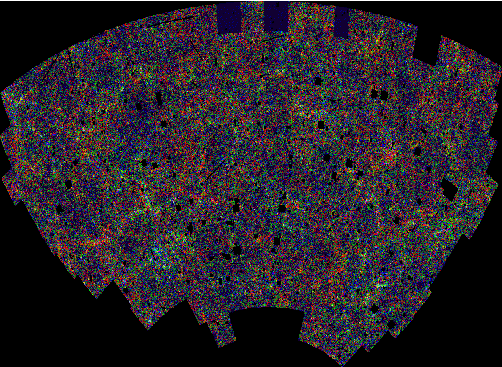
In 1917, Einstein realized that his equations of space, time and matter might be used to describe the universe as a whole. To achieve a simple description of the universe, Einstein had to neglect all the detailed structure of the universe, such as the presence of stars and galaxies and relatively empty space in between. Instead, he assumed that the universe could be approximated as a space with uniform density of matter everywhere, where the density of matter would be the average of the density taken over some large dimension, say 100 million light years. We call this assumption of uniformity -- throughout all space, and in every direction -- the cosmological principle. Actually, Edwin Hubble had already obtained evidence in support of the cosmological principle when he observed that the number of distant galaxies was almost the same in every direction.
Is the assumption of a uniform density universe reasonable? Below is a picture of a large part of the sky, about 30 degrees across, showing almost a million galaxies out to a distance of about 2 billion light years. You can see that at this scale, there are more-or-less the same number of galaxies everywhere. You might want to contrast this picture with the all-sky map of The Nearest 15,000 Galaxies, which reached only to about 500 million light years. On that scale, the universe is not smooth at all.

We may conclude from this picture that Einstein's assumption of a uniform universe is OK if we want to describe the behavior of the universe on a large-scale average, where "large-scale" means over distances greater than a few hundred million light years.
Today we have many other pieces of evidence that confirm that the universe is more-or-less the same everywhere on large scales - but it is not the same on "small" scales, where "small" means scales of clusters of galaxies and smaller - several hundred million light years!